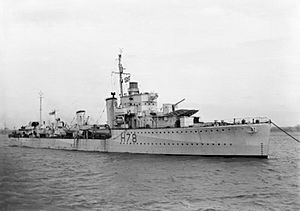Convoy SC 104 facts for kids
Quick facts for kids Convoy SC 104 |
|||||||
|---|---|---|---|---|---|---|---|
| Part of World War II | |||||||
 HMS Fame (September 1942) |
|||||||
|
|||||||
| Belligerents | |||||||
| Commanders and leaders | |||||||
| CinC:Admiral Karl Dönitz | Commodore: CAPT F H Taylor RN Escort: CDR R Heathcote |
||||||
| Strength | |||||||
| 8 U-boats | 48 freighters 2 destroyers 4 corvettes |
||||||
| Casualties and losses | |||||||
| 2 U-boats sunk 2 U-boats damaged 50 dead |
8 freighters sunk 2 destroyers damaged 216 dead |
||||||
Imagine a long line of cargo ships sailing across the huge Atlantic Ocean during World War II. This was a convoy, and its job was to carry important supplies like food, fuel, and weapons. Convoy SC 104 was one of these groups of ships. It was the 104th "Slow Convoy" to travel from Sydney, Nova Scotia in Canada to Liverpool in England.
In October 1942, this convoy faced a big danger. German submarines, called U-boats, hunted in groups known as "wolf packs." These U-boats attacked Convoy SC 104, sinking eight of its ships. However, the ships protecting the convoy fought back, sinking two of the attacking U-boats. This was a tough battle in the middle of the ocean.
Contents
Why Convoys Were Needed
During World War II, Germany used U-boats to try and stop supplies from reaching Britain. These supplies were vital for the war effort. To protect the cargo ships, they traveled together in convoys. Warships called "escorts" sailed with them to fight off U-boat attacks.
The U-boat Strategy
At first, U-boats attacked ships close to the American coast. But as the Allies got better at protecting these areas, the German U-boat commander, Admiral Karl Dönitz, changed his plan. He decided to send his U-boats into the middle of the Atlantic. This area was harder for planes to patrol.
Dönitz hoped that more U-boats would find convoys there. He also used secret information to help his U-boats find their targets. Even so, only about 20% of the convoys crossing the Atlantic between 1942 and 1943 were attacked by U-boats.
Convoy SC 104's Journey
Convoy SC 104 started its journey with 47 ships from New York City on October 3, 1942. They were met by a group of escort warships. This group included two destroyers, Fame and Viscount. There were also four smaller warships called corvettes, manned by brave Norwegian sailors: Potentilla, Eglantine, Montbretia, and Acanthus. A special "rescue ship" called Goathland also joined them.
Opposing them was a German U-boat "wolf pack" named Wotan. This group had 8 U-boats, including U-221, U-258, and U-356.
The Battle at Sea
The battle for Convoy SC 104 began on October 11. A U-boat, U-258, spotted the convoy and reported its location. Soon, other U-boats from the Wotan wolf pack were ordered to join the hunt.
First Attacks
By the evening of October 12, three U-boats were close to the convoy. During the night of October 12/13, they launched their first attacks. U-258 and U-356 were chased away by the escort ships. But U-221 was successful. It managed to sink three ships: the Norwegian cargo ships Senta and Fagersten, and the British cargo ship Ashworth.
More Attacks and Counter-Attacks
On October 13, the three U-boats continued to follow the convoy. Five more U-boats joined them during the day. That night, the wolf pack attacked again. U-221 sank two more ships: the American ship Susana and the British whale factory ship Southern Empress.
Another U-boat, U-607, hit the Greek ship Nellie, which later sank. However, U-607 was badly damaged by the escorts and had to return to France for repairs. U-661 sank the Yugoslavian ship Nikolina Matkovic, and U-618 sank the Empire Mersey.
Fighting Back
The escorts fought hard to protect the convoy. On October 15, in thick fog, the destroyer Viscount found U-661. Viscount attacked with guns, depth charges, and even rammed the U-boat. U-661 was destroyed, but Viscount was also damaged in the fight. It had to continue its journey as part of the convoy.
On October 16, the destroyer Fame spotted U-353. Fame attacked and destroyed the U-boat by ramming it. Fame also suffered damage. After this, Lieutenant Commander C.A. Monsen, on the corvette Potentilla, took command of the escort group. He later attacked another U-boat, U-254, which was severely damaged and forced to retreat.
Air Support and End of Battle
On October 16 and 17, Convoy SC 104 came within range of Allied aircraft. Long-range planes like B-24 Liberators and Catalina flying boats joined the fight. Their presence helped to break up any further U-boat attacks. On October 17, Admiral Dönitz called off the U-boat operations against Convoy SC 104.
The rest of the journey was safe, and the convoy reached Liverpool on October 21. In total, Convoy SC 104 lost 8 ships, and 2 escort ships were damaged. But the escorts successfully destroyed 2 U-boats and damaged 2 others.
U-boat Losses
| Date | Number | Type | Captain | Casualties | Position | Cause | By |
|---|---|---|---|---|---|---|---|
| 15 October 1942 | U-661 | VIIC | Oberleutnant zur See Erich Lilienfeld | 44 | 53°42′N 35°56′W / 53.700°N 35.933°W | Gunfire, depth charge, ramming | HMS Viscount |
| 16 October 1942 | U-353 | VIIC | Kapitänleutnant Wolfgang Römer | 6 | 53°54′N 29°30′W / 53.900°N 29.500°W | Depth charge | HMS Fame |
See also
- Convoy Battles of World War II

